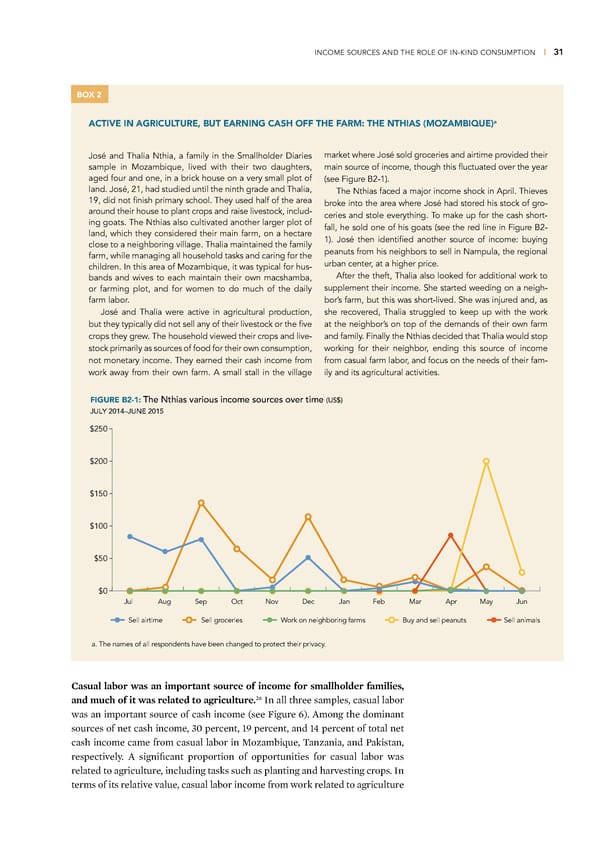INCOME SOURCES AND THE ROLE OF IN-KIND CONSUMPTION | 31 BOX 2 a ACTIVE IN AGRICULTURE, BUT EARNING CASH OFF THE FARM: THE NTHIAS (MOZAMBIQUE) José and Thalia Nthia, a family in the Smallholder Diaries market where José sold groceries and airtime provided their sample in Mozambique, lived with their two daughters, main source of income, though this fluctuated over the year aged four and one, in a brick house on a very small plot of (see Figure B2-1). land. José, 21, had studied until the ninth grade and Thalia, The Nthias faced a major income shock in April. Thieves 19, did not finish primary school. They used half of the area broke into the area where José had stored his stock of gro- around their house to plant crops and raise livestock, includ- ceries and stole everything. To make up for the cash short- ing goats. The Nthias also cultivated another larger plot of fall, he sold one of his goats (see the red line in Figure B2- land, which they considered their main farm, on a hectare 1). José then identified another source of income: buying close to a neighboring village. Thalia maintained the family peanuts from his neighbors to sell in Nampula, the regional farm, while managing all household tasks and caring for the children. In this area of Mozambique, it was typical for hus- urban center, at a higher price. bands and wives to each maintain their own macshamba, After the theft, Thalia also looked for additional work to or farming plot, and for women to do much of the daily supplement their income. She started weeding on a neigh- farm labor. bor’s farm, but this was short-lived. She was injured and, as José and Thalia were active in agricultural production, she recovered, Thalia struggled to keep up with the work but they typically did not sell any of their livestock or the five at the neighbor’s on top of the demands of their own farm crops they grew. The household viewed their crops and live- and family. Finally the Nthias decided that Thalia would stop stock primarily as sources of food for their own consumption, working for their neighbor, ending this source of income not monetary income. They earned their cash income from from casual farm labor, and focus on the needs of their fam- work away from their own farm. A small stall in the village ily and its agricultural activities. FIGURE B2-1: The Nthias various income sources over time (US$) JULY 2014–JUNE 2015 $250 $200 $150 $100 $50 $0 Jul Aug Sep Oct Nov Dec Jan Feb MarApr May Jun Sell airtime Sell groceries Work on neighboring farms Buy and sell peanuts Sell animals a. The names of all respondents have been changed to protect their privacy. ”asual labor was an important source of income for smallholder families, ‘¢ and much of it was related to agriculture €n all three samples, casual labor was an important source of cash income (see igure ¢) ˆmong the dominant sources of net cash income, Ÿ’ percent, …ž percent, and …“ percent of total net cash income came from casual labor in –o—ambiue, Œan—ania, and aistan, respectively ˆ significant proportion of opportunities for casual labor was related to agriculture, including tass such as planting and harvesting crops €n terms of its relative value, casual labor income from wor related to agriculture
 Financial Diaries with Smallholder Families Page 43 Page 45
Financial Diaries with Smallholder Families Page 43 Page 45